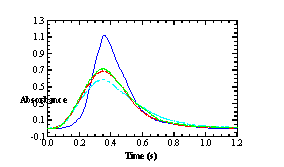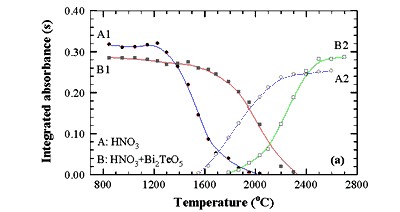
Fig. 1 Atomization transients of Cr in HCl with various additives; (A) HCl-Bi2TeO5-TAC, (B) HCl, (C) HCl-TAC, (D) HCl-Bi2TeO5, (E) Background absorption (for blank solution).
Grafitkemencés atomabszorpciós módszerek tanulmányozása bizmut-tellurit optikai egykristályok adalékelemeinek meghatározásához
Eötvös Loránd Tudományegyetem*
1999
Bevezetõ
Grafitkemencés atomabszorpciós spektrometriás (GFAAS) módszereket dolgoztunk ki a hologram tárolásra alkalmazható bizmut-tellurit (Bi2TeO5) egykristályok króm, erbium és neodímium adalékelemeinek meghatározására. A meghatározandó elemek, valamint a mátrix párolgási és atomizációs viszonyainak tanulmányozásához és a mérések optimálásához felvettük a Welz-féle elõkezelési és atomizációs görbéket. Tanulmányoztuk a különbözõ ásványi savakat tartalmazó közegek hatását a szóban forgó elemek atomabszorpciós jelére, mátrix jelenlétében és mátrix nélkül, kiértékelve a csúcs abszorbancia (Ap), és az integrált abszorbancia (Ai) adatokat.
Mátrix-hatás vizsgálata
Sósavas közegben a bizmut-tellurit feloldásánál
keletkezõ mátrix kloridsók a Cr, Er és Nd elemekre
különbözõ mértékû jelcsökkentõ
hatást fejtenek ki, ami a gázfázisban keletkezõ
kloridok csökkent atomizációjának következménye.
Az Ap jelekre a csökkenés kisebb mátrix koncentrációknál
következik be, mint az Ai jelekre. A zavaróhatás
megszüntethetõ a mátrixhoz ötszörös feleslegben
hozzáadott triammónium-citrát (TAC) kémiai
módosító alkalmazásával. A TAC jelenlétében,
az elõkezelési lépés során a klorid
nagyobb hányada kis hõmérsékleten elpárolog
ammónium-klorid formájában. Ennek következményeként,
az atomizáció során nem lép fel zavaróhatás
a gázfázisban.
Párologtatási kísérletek
Króm meghatározásához bizmut-tellurit jelenlétében kedvezõ a HCl-TAC tartalmú közeg, mivel közel kétszeresére növekszik az Ap értéke, egyszerû sósavas króm összehasonlító oldatok esetéhez képest. A szóban forgó hatás azzal magyarázható, hogy a króm az elõkezelési lépés során adszorbeálódik a TAC hõbomlásából visszamaradó "pirolízis maradékon", melyrõl az atomizáció gyorsabban megy végbe.
Oxosavas (HNO3, H2SO4) közegben adagolt króm elõkezelési görbéjének lehajlási pontja (megengedhetõ legnagyobb elõkezelési hõmérséklet) 1250oC, mely hõmérséklet mátrix jelenlétében 1500oC-ra növekszik. Ez a termikus stabilizáció a mátrix fémek oxidsóinak bomlásával keletkezõ oxigén hatásával magyarázható, amelynek hatására a króm(III)-oxid (Cr2O3) stabilizálódik.
Az erbium és a neodímium meghatározásához
ugyancsak elõnyös a HCl-TAC tartalmú közeg Bi2TeO5
jelenlétében. Az atomizáció alatti kis belsõ
argon gázáram ("mini-flow" Ė 40 cm3/perc) alkalmazása
mellett növekszik a meghatározások reprodukálhatósága
és csökken a memóriahatás. Ilyen gázáramlás
mellett a mátrix- és a meghatározandó elemek
csökkent kondenzációja érvényesül
a grafitcsõ hidegebb részein. A HCl-TAC esetén rövidebb
atomizációs idõ alkalmazható, ami növeli
a grafitcsõ élettartamát. A megállapított
optimális feltételek mellett a karakterisztikus tömegek
5,4 pg Cr, 42 pg Er és 320 pg Nd.
Modell-számítások
Kiterjesztettük a L'vov-féle, elméleti karakterisztikus tömeg számítására szolgáló modellt. Az új modell a grafitkemencében fellépõ diffúzió mellett tekintetbe veszi a konvektív gõztranszportot is. A mini gázáram és a megszakított gázáram feltételek mellett mért karakterisztikus tömegek aránya mindhárom elemre megegyezõ volt a meghatározások hibahatárán belül. Króm esetében az eltérõ gázáramlási feltételek alapján számolt (elméleti), és a mérésekbõl nyert (kísérleti) karakterisztikus tömegek aránya jó egyezést mutatott.
Kritikai megjegyzéseikért és szakmai támogatásukért Dr. Szakács Ottó témavezetõmnek és Dr. Kántor Tibornak mondok köszönetet.
* A kísérleti munka az MTA Szilardtest és Optikai Ku-tatóintézetében készült. Budapest, Konkoly-Thege u. 29-33
Study on graphite furnace atomic absorption methods
for the determination of dopants in bismuth tellurite optical single
crystals
PhD Thesis, Loránd Eötvös University of Sciences
1999
Introduction
Bismuth tellurite (Bi2TeO5) optical single crystals can be applied as holographic memories in optical devices. In the present work, graphite furnace atomic absorption spectrometry (GFAAS) methods were elaborated for the determination of Cr, Er and Nd dopants in bismuth tellurite. For studying the vaporization and atomization conditions of the analytes and the matrix, and for the optimization of the GFAAS conditions, the Welz-type thermal pretreatment and atomization curves were plotted. The effects of various mineral acidic media in the presence and in the absence of the matrix on peak height (Ap) and integrated absorbance (Ai) signals were also studied.
Matrix interferences
Atomization transients for chromium together with the corresponding Ai values are shown in Fig. 1. As can be seen, depressed absorbance signals are observed for the analytes in the presence of matrix and HCl medium, the Ap signals start to decrease at lower matrix concentrations than Ai signals. The signal depression is due to the reduced atomization of monochlorides in the gas phase. This halide interference could be successfully eliminated by the addition of five-fold molar excess of triammonium citrate (TAC) chemical modifier to the matrix (curve A in Fig. 1). In the presence of TAC, most of the chloride ions are removed at relatively low temperatures by volatilization in the form of ammonium chloride. As a consequence, no chloride interference occurs in the gas phase during atomization.
Vaporization studies
A noticable Ap signal enhancement and an increase in the appearance time (both by about a factor of two) was observed, when Cr solution contained additives of HCl-Bi2TeO5-TAC, whereas the enhancement was practically negligible on Ai signal, comparing to simple HCl standard solution (see Fig. 1). This effect can be explained by supposing that chromium is adsorbed on the "pyrolysis residue" of TAC formed during the thermal pretreatment stage. This results in a delayed, but faster desorption of Cr atoms from this carbonaceous layer in the course of the atomization stage.

Fig. 1 Atomization transients of Cr in HCl with various additives; (A) HCl-Bi2TeO5-TAC, (B) HCl, (C) HCl-TAC, (D) HCl-Bi2TeO5, (E) Background absorption (for blank solution).
When Cr is applied with Bi2TeO5 in oxo acidic (HNO3, or H2SO4) media, the declination points of the thermal pretreatment curves rise to 1500 oC, compared to the case without matrix (1250 oC), (see Fig. 2). This thermal stabilization is due to the decomposition of the matrix oxide salts, which release oxygen in the graphite tube, and stabilize chromium by preventing the decomposition of Cr2O3.

Fig. 2 Thermal pretreatment (1) and atomization (2) curves of Cr in nitric acid medium without (A) and with (B) matrix
For the determination of Er and Nd in Bi2TeO5, the application of HCl-TAC medium was also beneficial among the methods studied. Application of mini-flow argon gas stream (40 cm3/min) during the atomization stage provides more precise determinations and decreased memory effects. This is due to the less effective condensation of the matrix and analyte vapours at the cooler parts of the graphite tube, in the presence of the gas stream. The lifetime of the graphite tubes (i.e. the number of firings) are favourably increased, compared to oxo acidic media. Under optimized conditions the characteristic mass values are 5.4 pg Cr, 42 pg Er and 320 pg Nd.
Model calculations
An extension of the Lívov-model is presented for the calculation of the theoretical characteristic mass (m0). The new model, besides diffusion, takes into account the convective vapour transport, as follows in the next equation:
![]()
where Ar is the relative atomic mass of the analyte; ![]() is the Doppler-broadening of the analytical line; H(a,w
) is the intensity-distribution (Voigt) integral;
g is the correction factor for the fine and hyperfine splitting
and for the Doppler profile of the hollow cathode lamp; Z(T) is
the partition function at T temperature; g1 and
E1
are the statistical weight and energy of the lower level for the analytical
line, respectively; d is the correction coefficient
accounting for the presence of adjacent lines in the spectrum of the primary
source; r is the inner radius of the graphite tube; f is
the oscillator strength; k is the Boltzmann-coefficient; t
d
and tc are the residence time
factors accounting for the diffusion and convection of the analyte atoms,
respectively.
is the Doppler-broadening of the analytical line; H(a,w
) is the intensity-distribution (Voigt) integral;
g is the correction factor for the fine and hyperfine splitting
and for the Doppler profile of the hollow cathode lamp; Z(T) is
the partition function at T temperature; g1 and
E1
are the statistical weight and energy of the lower level for the analytical
line, respectively; d is the correction coefficient
accounting for the presence of adjacent lines in the spectrum of the primary
source; r is the inner radius of the graphite tube; f is
the oscillator strength; k is the Boltzmann-coefficient; t
d
and tc are the residence time
factors accounting for the diffusion and convection of the analyte atoms,
respectively.
Under mini-flow and gas-stop conditions the ratios of the characteristic masses (calculated from Ai signals) for the three analytes were near constant. For chromium, good agreement is found between the ratios of the calculated and experimental characteristic masses obtained under different gas flow conditions.
The critical comments and advices by Dr. Ottó Szakács
(supervisor) and Dr. Tibor Kántor are gratefully acknowledged.
Publications
1. Á. Péter, O. Szakács, I. Földvári, L. Bencs, A. Munoz F., Dopants in photorefractive bismuth tellurite (Bi2TeO5) crystals, Materials Research Bulletin, 31 (1996) 1067-1073.
2. L. Bencs, O. Szakács, Investigations on the determination of chromium dopant in bismuth tellurite single crystals by graphite furnace atomic absorption spectrometry, Spectrochimica Acta Part B, 52 (1997) 1483-1496.
3. L. Bencs, K. Raksányi, O. Szakács, L. Kovács, A. Watterich, Á. Péter, Removal of iron, chromium and sodium impurities from zinc tungstate (ZnWO4), Journal of Crystal Growth, 181 (1997) 455-458.
4. L. Bencs, O. Szakács, T. Kántor, Determination of erbium
and neodymium dopants in bismuth tellurite optical crystals by graphite
furnace atomic spectrometry techniques, Spectrochimica Acta Part B,
54
(1999) 1193-1206.
| Vissza a tartalomjegyzékhez
Back to Contents |
http://www.kfki.hu/chemonet/ |